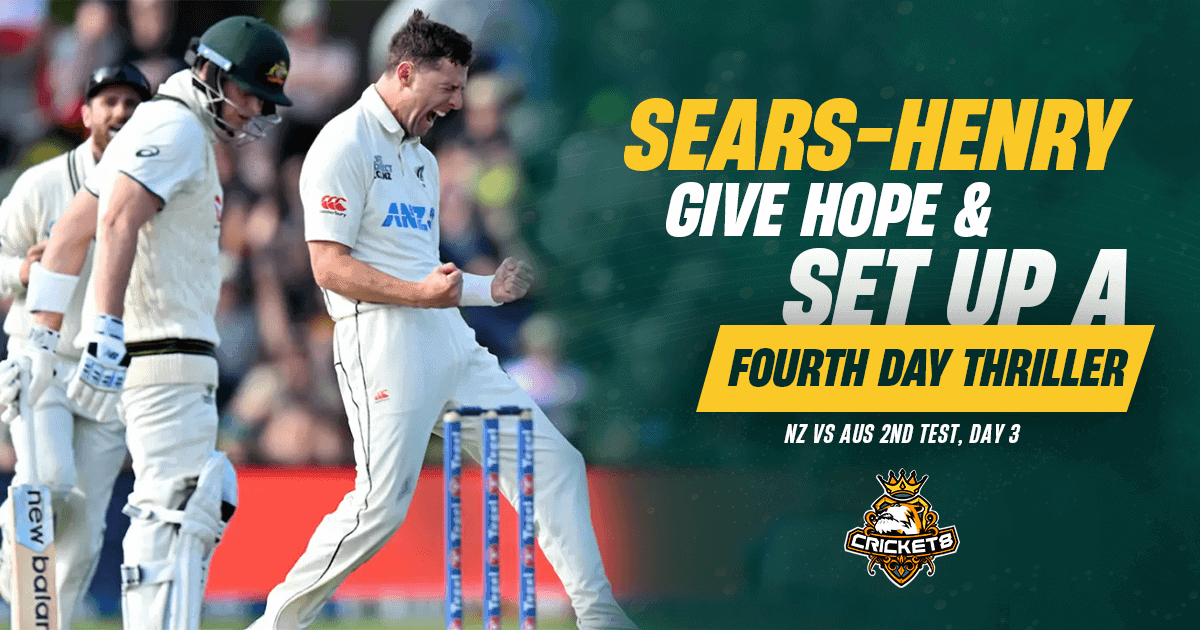After a fascinating day of Test cricket, the Christchurch Test hangs in the balance after three days of play. After the excellent display with the bat, the Kiwi bowlers took the mantle to dominate the proceedings. Matt Henry and Ben Sears both took two wickets apiece to put Australia in a tricky situation. Australian captain Pat Cummins would hope the pair of Mitchell Marsh and Travis Head would conjure up something special to guide their country towards a memorable win.
Team Lineups
Australia has fielded an unchanged side for the second time in this series. Steve Smith is still settling in his opening berth after the retirement of David Warner. Cameron Green finally justified his number four position in the batting order with a match winning performance in the first Test match at Basin Reserve. Marnus Labuschage and Alex Carey have recently come under heavy criticism after their constant failures with the bat. Travis Head is also underperforming with the bat since his heroics in the World Cup final.
The fabulous four in bowling with the pace trio of Patrick Cummins, Mitchell Starc and Josh Hazlewood looks settled as ever. These three bowlers offer different options for the captain Cummins throughout the game. Nathan Lyon is constantly moving towards new records having secured another ten-wicket haul in the last match.

New Zealand created history by defeating a South African side in a Test series for the first time in their history. However, their performances have been well below par in this series. They have made one change to their team that was comprehensively beaten in the last Test match at Basin Reserve. Will O”Rourke made way for Ben Sears who made his debut in the Test format. The New Zealand batting department failed miserably in the first Test match with Tom Latham enduring a bad patch in his career. Kane Williamson failed in both innings when the Kiwis needed their talismanic batsman to perform. Daryl Mitchell also struggled to play shots regularly in the first Test.
Rachin Ravindra was the exception by posting a memorable century in the first Test match. Tim Southee is yet to find the best form of his series. Scott Kuggeleijn’s inclusion in the team has sparked debuts throughout the cricketing community, but the 32 year old was selected for the second game running. Matt Henry was the pick of the bowlers for the New Zealanders in the first game and Kiwi captain would depend on this brilliant bowler to deliver early breakthroughs.
New Zealand
- Tom Latham 2. Will Young 3. Kane Williamson 4. Rachin Ravindra 5. Daryl Mitchell 6. Tom Blundell (WK) 7. Glenn Phillps 8. Scott Kuggeleijn 9. Matt Henry 10. Tim Southee (Cap.) 11. Ben Sears
Australia
1. Usman Khawaja 2. Steve Smith 3. Marnus Labuschagne 4. Cameron Green 5. Travis Head 6. Mitchell Marsh 7. Alex Carey (WK) 8. Mitchell Starc 9. Pat Cummins (Cap.) 10. Nathan Lyon 11. Josh Hazlewood
Australian captain Patrick Cummins won the toss and sent the Kiwis to bat first. The Hagley Oval pitch in Christchurch usually offers a pacer friendly track. The greenish top would allow the pace bowlers to use the new ball to get some swing. The pitch also enables the bowlers to get enough bounce off the surface. However, it is tough to predict the nature of the pitch at Hagley Oval. In the last three years, the highest team total, highest successful run chase and lowest team total records have been broken at this venue.
The fast bowlers and the batters may receive assistance from this surface. The average first innings score is 320 at this ground. The teams that have fielded first have secured seven wins at this ground. So, the captain winning the toss would be tempted to bowl first under the favourable conditions.
The playing surface was assisting the pace bowlers by letting them generate bounce and movement. The carry to the wicketkeeper is also fine in terms of the pace. But on the third day, the pitch may help the batters as the balls would come to bat more easily. Pat Cummins would look to up the ante by deploying a world class pace attack against the Kiwi batters who have struggled throughout the series.
Fixture
The historic Trans-Tasman rivalry between Australia and New Zealand is poised to reignite in a thrilling showdown as they gear up for the inaugural Test of the highly anticipated two-match series commencing on February 29th (Thursday), vying for the prestigious Chappell-Hadlee Trophy.
Australia is embarking on a momentous red-ball tour of their neighbouring arch-rivals for the first time since the memorable encounters of February 2016. Back then, Australia asserted their dominance emphatically, clinching a commanding 2-0 triumph over the Kiwis.
The Aussies undeniably hold the upper hand over the Blackcaps in the traditional red-ball format, boasting a stellar record with 35 victories out of the 61 Tests contested, while New Zealand has mustered only eight wins, with 18 matches culminating in a stalemate.
Armed with the aura of reigning champions of the World Test Championship, Australia strides into the series brimming with confidence following their recent resounding success in the T20I series, where they outclassed New Zealand with a clinical 3-0 whitewash. Nonetheless, New Zealand draws inspiration from their commendable performance against a makeshift South African squad in the recent two-match Test series.
Offering a sneak peek into the battlefield, the Hagley Oval in Christchurch unveils a pitch shrouded in a lush green cover for the impending contest. The verdant hue promises to favour the seamers from both camps, potentially posing a formidable challenge for the team tasked with setting the tone in the opening innings. Notably, the historic venue has witnessed outcomes in 11 out of the 12 Tests held within its precincts, with a remarkable 7 of those victories belonging to sides that opted to unleash their bowling arsenal first.
With the promise of moisture-laden conditions and the allure of fresh grass blades, the bowlers entrusted with embarking on this cricketing odyssey stand poised to exploit the early advantage offered by the Hagley Oval wicket, setting the stage for a compelling battle between bat and ball.
| Venue | The second day of the first Test match between Australia and New Zealand was played at The Hagley Oval, Christchurch, New Zealand. |
| Date | The second day started on Sunday, March 10, 2024, at 10:00 a.m. local time. |
Captaincy & Tactics
New Zealand are on the cusp of a historic Test victory, their first over Australia on home soil in over 30 years, after a dominant day with the bat followed by a ruthless new-ball assault that exposed deep flaws in Australia’s top order.
Chasing a mammoth 279 runs for victory, the highest chase ever attempted by Australia on New Zealand soil, the tourists find themselves precariously placed at 4-77 with two days remaining. Travis Head (17*) and Mitchell Marsh (27*) are the only batsmen to show any resistance, leaving Australia needing a further 202 runs to pull off an improbable heist.

Australia’s batting woes continued, mirroring their struggles throughout the series. They slumped to a concerning 4-34 after reaching 300 just once in their previous seven innings. The Hagley Oval crowd, electric from the first ball, erupted in jubilation as wickets tumbled in quick succession.
Matt Henry, the hero of the day, picked up where he left off in the first innings, dismissing Steve Smith for a paltry 9 runs. This dismissal, upheld by DRS, raised concerns about Smith’s recent struggles as an opener. His scores in the series paint a worrying picture: 12, 11no, 6, 31, 0, 11, and now 9. The pattern is clear – either caught behind the wicket or trapped lbw when the new ball deviates.
Adding to Australia’s woes was the debut of Ben Sears. Though he dropped Marnus Labuschagne in the ninth over, he redeemed himself two balls later, dismissing the batsman for 5. The introduction of the new ball also accounted for the wickets of Usman Khawaja and Cameron Green, leaving Australia in tatters.
While Australia can draw some solace from their remarkable comeback victory against Sri Lanka at Hagley Oval last year, chasing down 285 after losing early wickets, the current situation seems far more dire. Their current batting form suggests that overcoming a deficit of 202 runs is a near-impossible task.
A glimmer of hope remains for the tourists. The Hagley pitch offers significant assistance with the new ball, a fact Pat Cummins exploited earlier in the day, taking four crucial wickets and dragging his team back into the contest. New Zealand, who looked set for a lead of over 300 thanks to a century partnership between Mitchell and Ravindra, crumbled under the pressure of the second new ball, losing 7 wickets for just 118 runs.
While the pitch might be a double-edged sword, Australia will need their remaining batsmen to show immense grit and determination if they are to even entertain the possibility of a win. New Zealand, on the other hand, are on the verge of a historic triumph. They will be desperate to take the remaining six wickets and etch their names in cricketing history. The stage is set for a thrilling finish, with both teams leaving everything on the field for a momentous victory.
Batting Analysis
The Black Caps are inching closer to a historic home Test victory over their long-standing rivals, Australia, as they dominated the proceedings on day three of the Christchurch Test. With Australia struggling at 4-77 in pursuit of a challenging 279-run target set by New Zealand, the Kiwis find themselves on the brink of breaking an 11-match drought against their Trans-Tasman counterparts on home soil, dating back to 1993.
The talented paceman, Matt Henry, and debutant Ben Sears stamped their authority with the new ball, causing havoc in the Australian top order. Henry’s impeccable line and length led to the dismissal of key batsmen, including the prized wicket of Steve Smith, while Sears made an immediate impact by denting Marnus Labuschagne early in his innings.
Despite a dropped catch off Labuschagne’s bat, the Kiwis remained composed as Sears managed to claim Labuschagne’s wicket soon after with a sharp return catch. The dismissals of Usman Khawaja and Cameron Green further solidified New Zealand’s stronghold, with Henry’s stellar performance yielding nine wickets in the match.

As the day drew to a close, Travis Head and Mitchell Marsh displayed resilience at the crease to keep Australia’s hopes alive, needing 202 runs to secure an unlikely victory. However, the odds currently favor New Zealand, with the home team poised to capitalize on their strong position and end the drought against their formidable opponents.
In the earlier phases of the match, the Black Caps showcased their batting depth and determination, with notable contributions from Rachin Ravindra, Daryl Mitchell, and Scott Kuggeleijn. Their solid partnerships and aggressive stroke play laid the foundation for a competitive total of 372, putting Australia under pressure from the outset.
Despite some spirited bowling performances from the Australian camp, including Pat Cummins and Nathan Lyon, New Zealand’s middle-order resilience and lower-order partnerships proved to be crucial in their quest for a historic victory. The match is finely poised as it heads into the final day, promising an exciting conclusion to what has been a gripping Test match between the two fierce rivals.
Bowling Analysis
Matt Henry’s remarkable journey with a titanium cable and screws in his spine since a critical surgery back in 2012 has been nothing short of inspirational. Carrying the weight of expectations and the hopes of his country, he delivered a stellar performance in the second Test against Australia, picking up a sensational seven-wicket haul that turned the tide in favor of New Zealand.
His presence on the field was commanding, with Henry appearing as a one-man army at times, wreaking havoc on the Australian batting lineup. While runs came easily from one end, facing Henry at the other end turned the pitch into a challenging battlefield for the opposition. His skillful bowling, late movement, and impeccable line and length made him a formidable force to reckon with.
New Zealand skipper Kane Williamson applauded Henry’s extraordinary effort, highlighting the difficulty he poses for batsmen on surfaces offering some assistance. Henry’s ability to extract movement late in the delivery made life challenging for the Australian batsmen, and his valuable contributions were instrumental in turning the match in New Zealand’s favor. His bowling style resembles that of Josh Hazlewood, who has taken five wickets in the first innings.

Henry’s bowling exploits on both day one and day two were a masterclass in perseverance and skill. He outsmarted the Australian top order, forcing errors and claiming crucial wickets with precision. His ability to adapt to the conditions and capitalize on opportunities was commendable, showcasing his resilience and determination.
Despite facing setbacks and limited opportunities in the past, Henry’s perseverance and hard work have finally paid off. His seven-wicket haul in the match was a testament to his unwavering commitment to excellence and his ability to rise to the occasion when the team needed him the most.
With 15 wickets in the series so far, Henry has emerged as a potent weapon in New Zealand’s bowling arsenal, surprising the Australian batters with his exceptional performance. His recent success at Hagley Oval, where he has been exceptional with the ball, has cemented his reputation as a key contributor to the team’s success.
Matt Henry’s journey is a testament to his resilience, determination, and unwavering spirit. He has defied the odds, overcome challenges, and emerged as a vital asset for New Zealand cricket. His inspiring performance has instilled hope and belief in his team, proving that with dedication and hard work, anything is possible.
Fielding Performance
The top fielding moment of the day was provided by the brilliance of Marnus Labuschagne at covers. Tom Blundell was presented with a good length delivery by Cameron Green. Blundell slashed the ball hard and it flew towards Marnus Labuschagne. The right handed batsman moved quickly towards his left and reverse cupped it to dismiss the New Zealand wicketkeeper. Cameron Green also produced a fine moment of his own with a good catch to dismiss Scott Kuggeleijn. Alex Carey equalled the record of the highest Test catch in a match with 10. The wicketkeeper is having a torrid time with the bat but his keeping performances have been top notch as usual. Carey took five catches in the second innings of the match.
New Zealand’s fielding in the fourth innings of the match would please their fans. Veteran Tim Southee took an one-handed blinder at third slip to send Usman Khawaja back to the pavilion. Ben Sears also produced a magical moment by catching Marnus Labuschagne out off his own bowling.
Key Performances
Hagley Oval witnessed a day of high drama on day three of the second Test as Australia and New Zealand locked horns in a tense battle for series supremacy. Set a challenging target of 279 runs to win and clinch the series 2-0, Australia found themselves in early disarray, losing their top order cheaply.
New Zealand’s bowling attack, spearheaded by the fiery Matt Henry and debutant Ben Sears, ripped through the Australian top order. Smith, Khawaja, Labuschagne, and Green all fell cheaply, leaving Australia reeling at a precarious 34 for 4. The spotlight intensified on Smith’s recent struggles, as he could only manage a paltry 9 before being trapped lbw by Henry.
However, just as despair threatened to engulf the Australian camp, a resolute partnership between Mitchell Marsh and Travis Head emerged as a beacon of hope. Marsh, known for his fearless batting, smashed a boundary off his very first ball, showcasing his unyielding spirit. Head, on the other hand, adopted a more cautious approach, anchoring the innings while Marsh counterattacked bravely. Their 43-run stand before stumps left Australia at 77 for 4, needing a further 202 runs for an improbable victory.
Earlier in the day, Australia had restricted New Zealand’s lead after Pat Cummins delivered a superb bowling spell. A crucial 53-run partnership between Glenn Phillips and Scott Kuggeleijn threatened to push New Zealand’s lead beyond 300 runs. However, a sudden collapse saw them lose their last four wickets for just 23 runs, getting bowled out for 372 shortly after tea. Cummins emerged as the hero for Australia, finishing with a stellar 4 for 62, while Nathan Lyon ripped through the lower order with his sharp turn, claiming three wickets.
New Zealand’s fightback had been impressive, especially considering their meager first-innings total of 162. Daryl Mitchell and Rachin Ravindra had provided a glimmer of hope with their 123-run partnership, the highest of the match for either team. However, the introduction of the second new ball proved pivotal, with Josh Hazlewood and Cummins taking crucial wickets to derail New Zealand’s momentum.
The turning point, however, arguably came with Cummins’ dismissal of Latham early in the day. Latham, eyeing his first Test century against Australia, fell victim to a sharp delivery that reared off the pitch. This dismissal halted New Zealand’s progress and allowed Australia to claw their way back into the contest.

With the match delicately poised, day four promises to be an enthralling spectacle. Australia will need their remaining batsmen to show grit and determination if they are to chase down the target. New Zealand, on the other hand, will be desperate to take the remaining six wickets and claim a rare Test victory against their trans-Tasman rivals. The stage is set for a grandstand finish, with both teams leaving everything on the field for a historic win.
Turning Point
The game changed in the ninth over of the Australian second innings. Debutant Ben Sears had a rollercoaster ride in that over. A golden opportunity to dismiss Marnus Labuschagne presented itself when the Australian batsman, unsettled by the extra pace and bounce, edged a delivery towards first slip. However, disaster struck for New Zealand as Daryl Mitchell inexplicably spilled the knee-high chance to his right. The collective groan from the Hagley Oval crowd was almost palpable.
But cricket, as they say, is a game of glorious uncertainties. Sears’ initial dejection quickly transformed into elation just two balls later. Labuschagne, perhaps lulled by the dropped catch, attempted to flick a fuller delivery on the leg side. The ball, however, had other ideas. It held up unexpectedly on the pitch, looping off the splice of Labuschagne’s trusty “old faithful” bat straight back to the grateful bowler. Sears, who had claimed his maiden Test scalp – Steve Smith – in the first innings, couldn’t believe his luck. He had snatched victory from the jaws of defeat, turning despair into delight in a matter of seconds.
With Labuschagne’s dismissal, the weight of expectation shifted to the shoulders of Usman Khawaja, the reigning Test player of the year, and the in-form Cameron Green, whose unbeaten 174 in the first Test remained the solitary century of the series. However, Khawaja’s struggles mirrored those of Smith. He fell victim to a familiar pattern, pushed back in his crease by a probing delivery from Matt Henry. The resulting edge found Tim Southee at his absolute best. The New Zealand captain flung himself low to his left, miraculously clinging on to the ball with his fingertips even as he crashed to the turf. It was a sensational catch, one that epitomized New Zealand’s determination on the day.
Khawaja’s dismissal exposed the chinks in Australia’s top order once again. His struggles for form, with only a single score above 50 in his previous 12 innings, mirrored those of Smith. The pressure then fell on the young shoulders of Green. However, a lapse in concentration proved costly. He attempted to leave a delivery from Sears that had more bounce than anticipated. The ball snuck under his bat, taking a bottom edge and crashing into the base of the middle stump.
With Australia now in tatters at 4-34, needing a further 245 runs for an improbable victory, their only hope seemed to be drawing parallels with the corresponding Test at Hagley Oval last summer. In that match, the Black Caps successfully chased down a target of 285 against Sri Lanka despite losing early wickets. However, replicating such a feat against a rejuvenated New Zealand bowling attack appeared a daunting proposition, to say the least.
Day Result
The Australians need 202 runs to win the second Test match and seal the series at 2-0. On the other hand, the New Zealanders are 6 wickets away from a win that would level the Chappell-Hadlee series. Travis Head and Mitchell Marsh would resume the batting on the fourth day of this enthralling Test match.
Brief Scorecard
| New Zealand First Innings: 162/10 (45.2 overs) | Australia First Innings: 256/10 (68 overs) | New Zealand Second Innings: 372 (108.2 overs) | Australia Second Innings: 77/4 (24 overs) |
| Tom Latham 38 (69) | Marnus Labuschagne 90 (147) | Rachin Ravindra 82 (153) | Mitchell Marsh 27 (27) |
| Matt Henry 29 (28) | Mitchell Starc 28 (54) | Tom Latham 73 (168) | Travis Head 17 (39) |
| Josh Hazlewood 5/31 (13.2 overs) | Matt Henry 7/67 (23 overs) | Pat Cummins 4/62 (24 overs) | Ben Sears 2/22(6 overs) |
| Mitchell Starc 3/59 (12 overs) | Glenn Phillps 1/14 ( 5 overs) | Nathan Lyon 3/49 (16.2 overs) | Matt Henry 2/37 (9 overs) |
Day Highlights
Day Wrap-Up
New Zealand batters hit form just at the right time to challenge the Australian bowlers in the second innings. Rachin Ravindra and Tom Latham took the Kiwi lead to a substantial amount with responsible batting. In reply, the Australian top order was decimated by the fierce pace of Ben Sears and swing of Matt Henry. The fourth day awaits with all the thrills and chills of a closely contested Test match.




